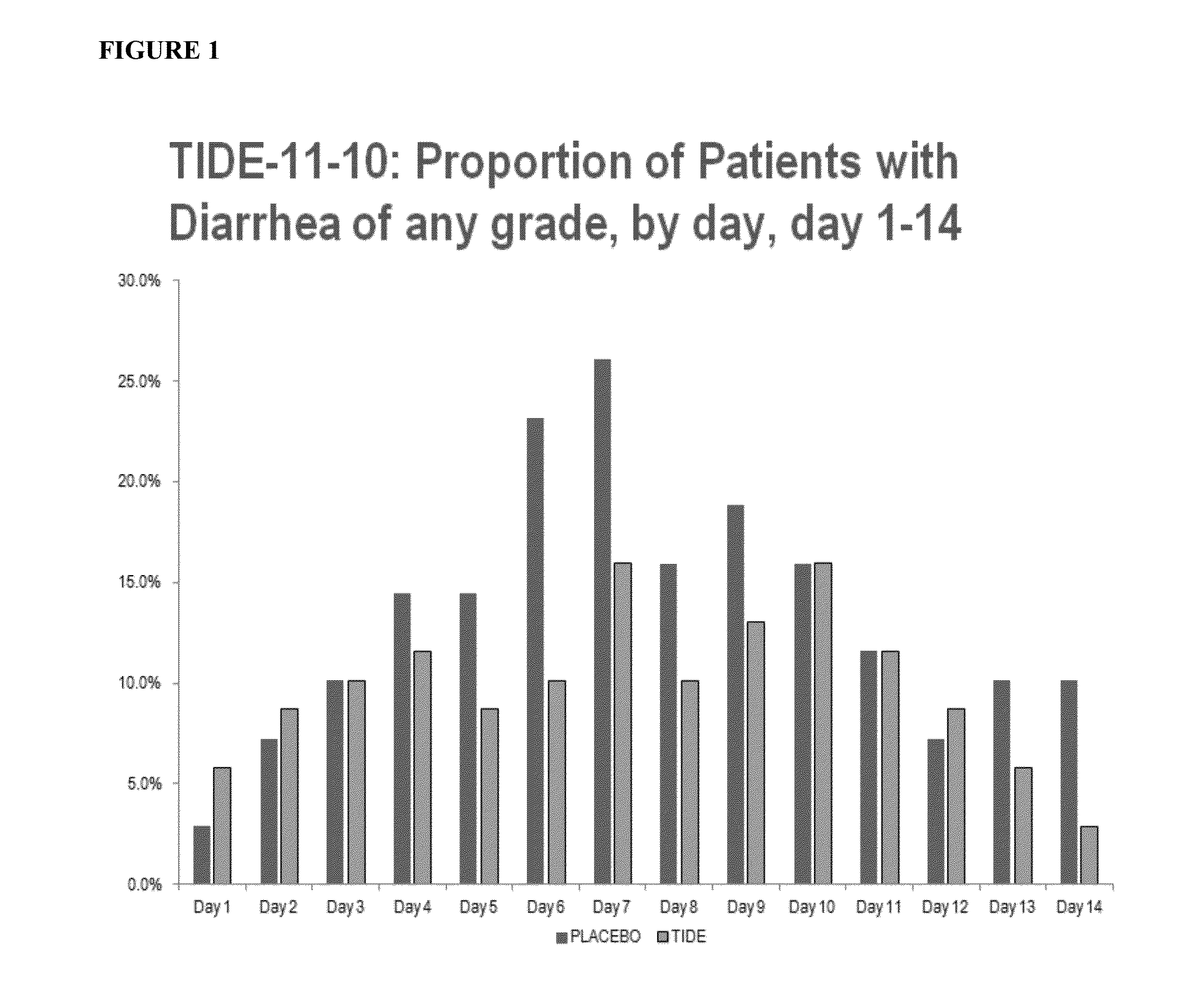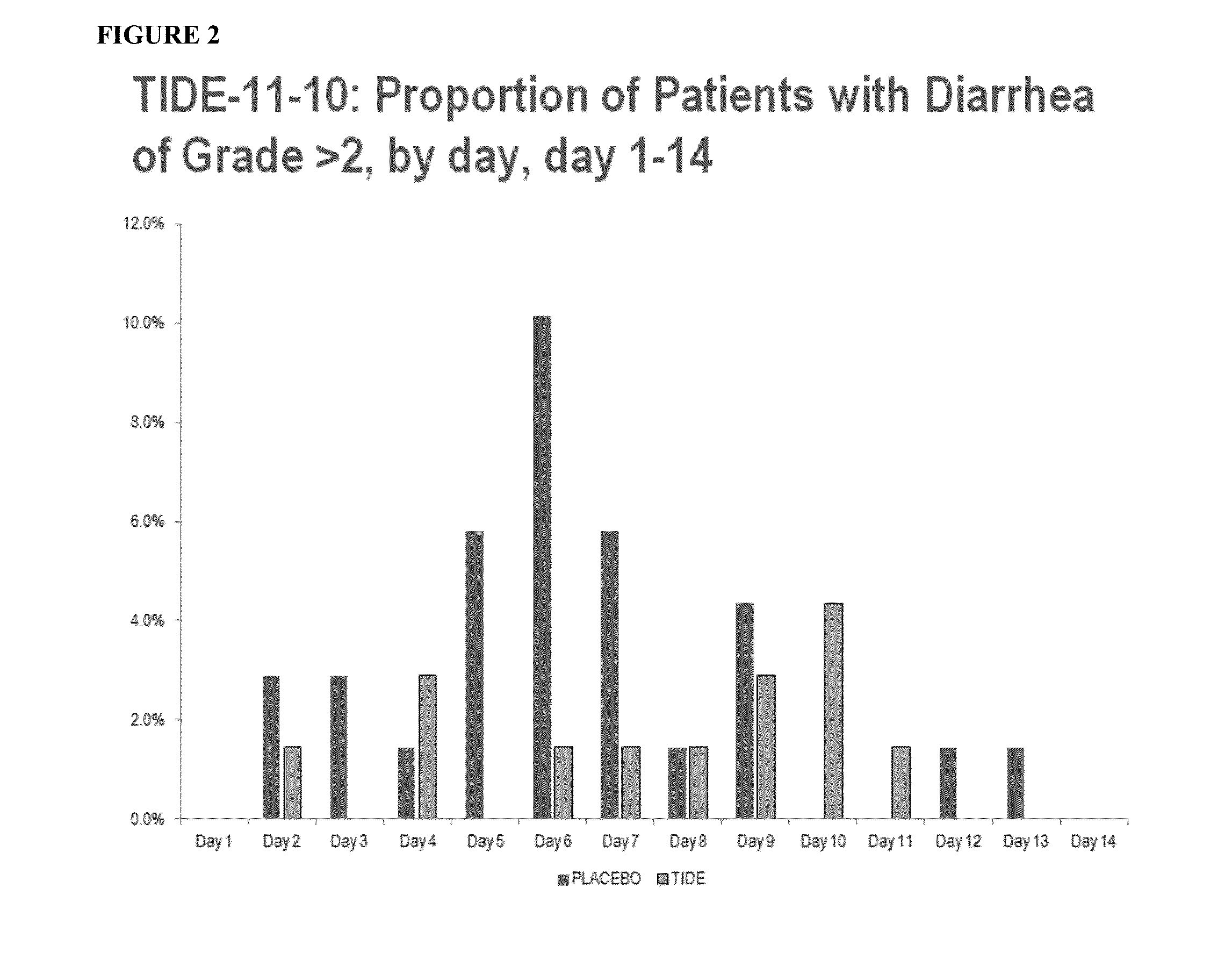Use of elsiglutide to treat gastrointestinal mucositis including chemotherapy-induced diarrhea
a technology of elsiglutide and elsiglutide, which is applied in the direction of extracellular fluid disorder, antibody medical ingredients, metabolic disorders, etc., can solve the problems of severe dehydration, sepsis, and potentially life-threatening, and achieve the effects of preventing or reducing the occurrence of grade 2 or higher cid, and preventing or reducing the occurrence of cid
- Summary
- Abstract
- Description
- Claims
- Application Information
AI Technical Summary
Benefits of technology
Problems solved by technology
Method used
Image
Examples
example 1
Initial Clinical Characterization of Elsiglutide
[0056]1.1. Summary of Clinical Data
[0057]Data on human exposure to elsiglutide generated so far originate from three clinical trials, one performed in healthy subjects (study 06-013) and two in cancer patients (TIDE-09-04, TIDE-11-10). The main objective of the first two studies was the evaluation of the safety, tolerability and maximum tolerated dose (MTD) of ascending elsiglutide doses administered as s.c. (both studies) and i.v. (only study 06-013) bolus injections. In study 06-013 elsiglutide was administered as single i.v. or s.c. bolus, while in study TIDE-09-04 each dose was administered as s.c. bolus on 4 consecutive days. Study TIDE-11-10 was a phase II proof of concept study that mainly evaluated the efficacy of elsiglutide administered as 24 mg daily s.c. bolus injections for 4 consecutive days in preventing CID in patients with colorectal cancer receiving 5-FU based chemotherapy (FOLFOX4 or FOLFIRI regimen). The secondary o...
example 2
Follow-On Clinical Trial to Determine Optimal Dose and Regimen for Elsiglutide Effect on CID
[0094]TIDE-13-22: Randomized, Double Blind, Parallel Group, Placebo-Controlled, Dose Finding Study in Colorectal Cancer Patients Receiving 5-FU Based Chemotherapy to Assess the Efficacy of Different Doses of s.c. Elsiglutide in the Prevention of Chemotherapy Induced Diarrhea (CID)
[0095]The use of chemotherapy regimens for colorectal cancer treatment evolves continuously in all countries. In order to have a homogeneous patient population, the present study is planned to be conducted on patients with colorectal cancer scheduled to receive any FOLFOX (fluorouracil, folinic acid and oxaliplatin) or FOLFIRI (fluorouracil, folinic acid and irinotecan) chemotherapy regimens. These regimens have been described to cause CID in 30-80% of treated patients (Cherny, J Pain Symptom Manage 2008; 36:413-23; Arnold et al., J Support Oncol 2005; 3:227-232; Tournigand et al., J Clin Oncol. 2004; 22:229-237). Co...
PUM
| Property | Measurement | Unit |
|---|---|---|
| time | aaaaa | aaaaa |
| time | aaaaa | aaaaa |
| time | aaaaa | aaaaa |
Abstract
Description
Claims
Application Information
 Login to View More
Login to View More - R&D
- Intellectual Property
- Life Sciences
- Materials
- Tech Scout
- Unparalleled Data Quality
- Higher Quality Content
- 60% Fewer Hallucinations
Browse by: Latest US Patents, China's latest patents, Technical Efficacy Thesaurus, Application Domain, Technology Topic, Popular Technical Reports.
© 2025 PatSnap. All rights reserved.Legal|Privacy policy|Modern Slavery Act Transparency Statement|Sitemap|About US| Contact US: help@patsnap.com



